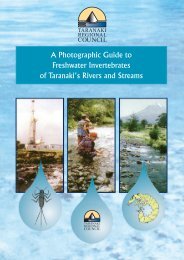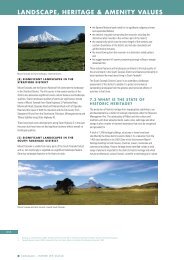Annual report 2006-2007 - Taranaki Regional Council
Annual report 2006-2007 - Taranaki Regional Council
Annual report 2006-2007 - Taranaki Regional Council
You also want an ePaper? Increase the reach of your titles
YUMPU automatically turns print PDFs into web optimized ePapers that Google loves.
Further downstream at Flint Road, the macroinvertebrate community remained very similar<br />
in community structure and indicated similar stream ‘health’, although there was a recovery<br />
in the SQMCIS score at this site. None of the rest of the Kahouri Stream sampling sites<br />
further downstream showed any significant adverse effects as a result of industrial<br />
discharges to this catchment, consistent with the absence of any significant heterotrophic<br />
growths on the stream substrate.<br />
The macroinvertebrate communities of the Kahouri Stream were generally characterised by<br />
moderate taxonomic richnesses at the time of this April <strong>2007</strong> survey despite a period of<br />
relatively low flows during the latter part of summer. These communities continued to<br />
support abundances of several ‘sensitive’ taxa at all main stream sites, from upstream of the<br />
<strong>Taranaki</strong> Abattoir, to the confluence with the Piakau Stream. All sites had relatively similar<br />
communities, particularly in terms of those taxa characteristic to each site. For example,<br />
eight taxa dominated the communities of nearly all of the six Kahouri Stream sites.<br />
Most MCI scores were similar to historical median MCI scores, and higher SQMCIs scores<br />
than historical medians were recorded throughout the stream. There was some longitudinal<br />
deterioration throughout the catchment, a trend which is usually present in agricultural<br />
ringplain catchments due to non-point source discharges and is demonstrated by decreasing<br />
median MCI and SQMCIs scores in a downstream direction from past surveys. <strong>Taranaki</strong><br />
ringplain streams’ communities have been shown to decrease in MCI scores at an average<br />
rate of 2.6 MCI units/km along their total length, probably at a higher rate than this toward<br />
the upper reaches. This would equate to a theoretical drop in MCI of about 21 units over the<br />
length of the Kahouri Stream surveyed, more typical of the decrease illustrated somewhat<br />
median scores to date (ie: 17 units). The current survey recorded a decrease of 23 units, a rate<br />
of 2.9 MCI units/km. This is higher than what has been recorded in previous surveys, which<br />
attributed a lack of a significant trend to the moderation of algae growth due to good<br />
riparian vegetation cover along the banks of the Kahouri Stream in the reach monitored. The<br />
trend seen in this survey is largely the result of an above average community at the top site,<br />
coupled with a below average community at the downstream site.<br />
Site D in the Kahouri Stream tributary would be expected to support ‘poorer’<br />
macroinvertebrate communities than those of the Kahouri Stream due to the clay substrate,<br />
but in this survey the community contained many ‘sensitive’ taxa and had relatively high<br />
MCI and SQMCIs scores, indicating no detrimental effects from discharges in the Stratford<br />
industrial area in the upper part of the tributary which includes discharges from <strong>Taranaki</strong><br />
Galvanizers, Egmont Tanneries and Firth Industries.<br />
Generally these April <strong>2007</strong> results suggested that the Kahouri Stream was in good ‘health’<br />
compared with past monitoring years, throughout the 8 km reach surveyed. Any changes in<br />
macroinvertebrate community composition with distance downstream were not indicative<br />
of any significant decline in water quality and therefore reflected no recent impacts of pointsource<br />
discharges in this part of the catchment. There is some indication of impacts from the<br />
<strong>Taranaki</strong> Abattoirs site, and therefore it is recommended to increase the scope of following<br />
surveys, to include impacts of this site on their unnamed tributary. The lower unnamed<br />
tributary did not have any detectable effect on the macroinvertebrate fauna downstream of<br />
its confluence with the Kahouri Stream.<br />
14














